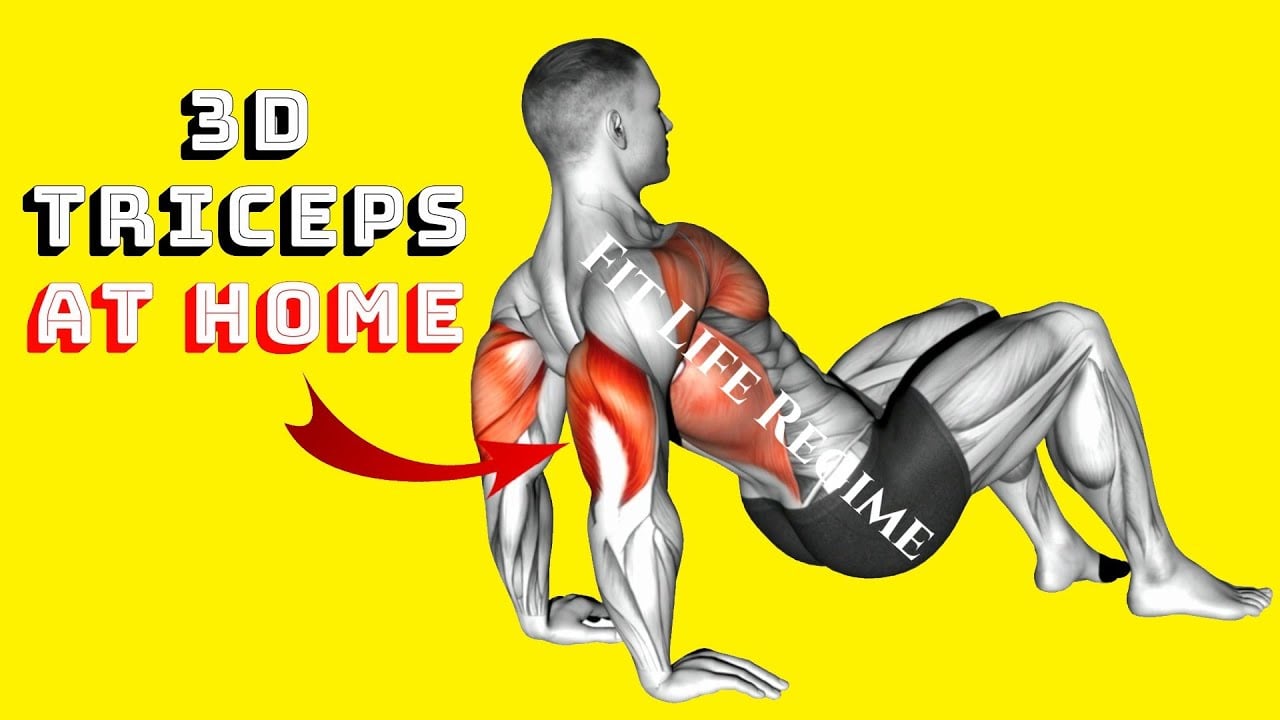If you are looking for the best exercise to build stronger arms in the comfort of your home? Then bench dips may be your answer. They only need a bench or other sturdy surface.
Bench dips are a simple exercise that can be done almost anywhere. They have many variations to match your fitness level. You could also use them as part of a strength workout for your upper body.
The tricep bench dip is one of the best bodyweight exercises, but be cautious: Due to shoulder internal rotation, it can put your shoulder in a dangerous position.
Here, I will explain how to maximize the benefits of this workout and maintain proper form. After that, you can be able to do a weighted bench dip to progressive muscle overload.
When performed with strict form, the bench dip is an effective exercise to build your triceps, even if you do it with body weight alone. It will also target the shoulders (anterior delt), chest (pectorals), and serratus anterior.
In this article, you will learn everything you need to know about:
- How to perform the bench dips correctly.
- How to avoid common mistakes
- What are the best variations of bench dips, and how do they?
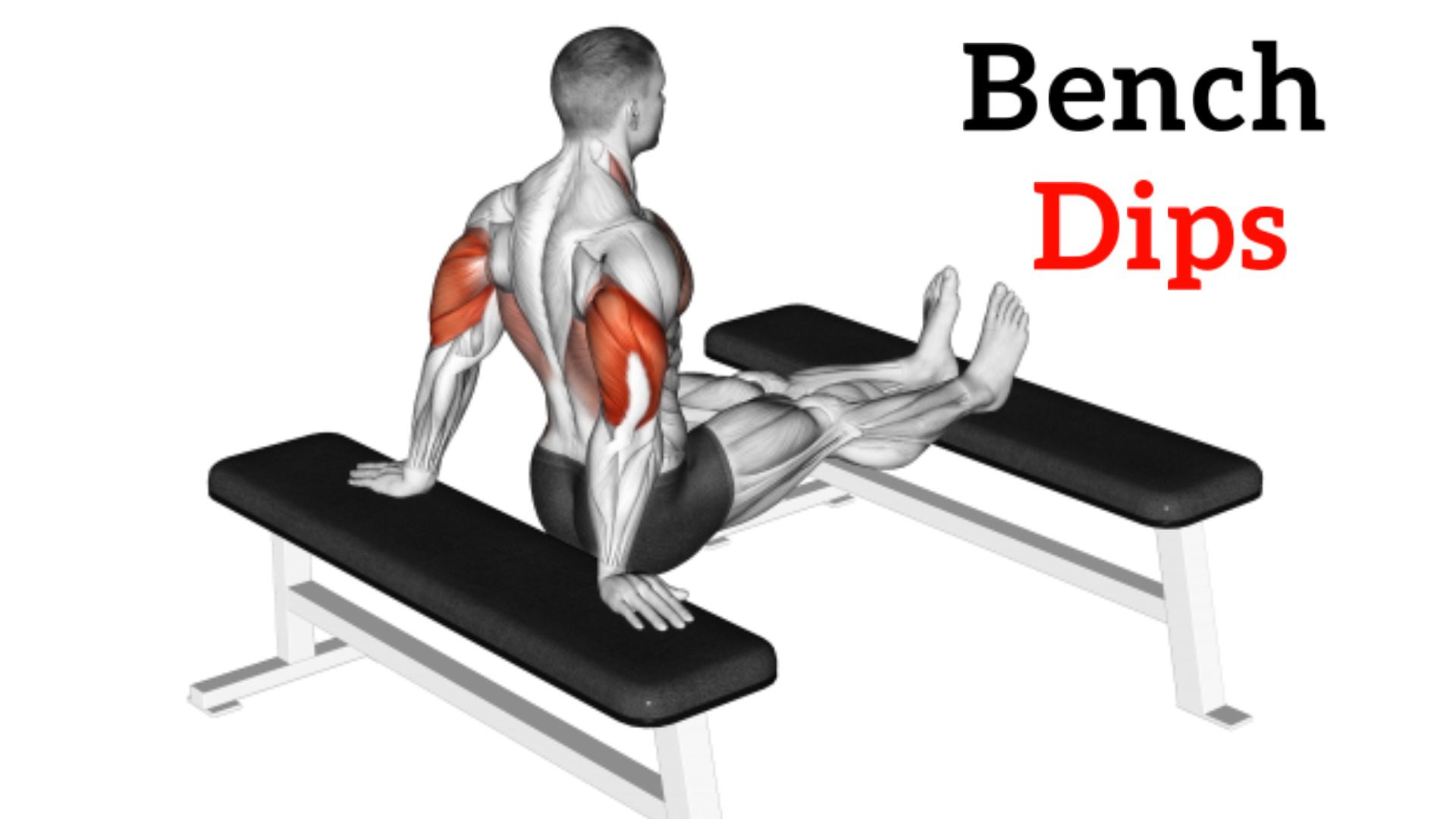
- Muscles Worked During Bench Dip
- How To Do Tricep Bench Dip
- Avoid This Common Mistakes While Doing Bench Dips
- 1. Not Doing Complete Reps
- 2. Flaring Elbows Out
- 3. Leaning Too Far Forward
- 4. Going too Low
- 5. Locking Elbows
- 6. Doing Reps too Quick
- 7. Start Lifting Heavy
- 8. Not Following Optimum Sets, Reps, & Frequency for Bench Dip
- Bench Dip Variations (Make It Easier Or Harder)
- 1. Knee Bent Bench Dip
- 2. Bench Dip With Straight Legs
- 3. Weighted Bench Dip
- 4. One-arm Bench Dip
- FAQ
- Do dips work all 3 heads?
- Can I do bench dips every day?
- Are dips better than push-ups?
- How can you add this In routine?
- Do bench dips work the lower chest?
- How Many sets and Reps?
- Takeaways
- References
Muscles Worked During Bench Dip
- Bench dips primarily target the triceps muscles.
- In addition to the triceps, bench dips also engage the anterior deltoids (front shoulders) and pectoralis major (chest muscles) as stabilizers.
- Bench dips also work the rhomboids and trapezius muscles in the upper back to keep the shoulder blades stable.
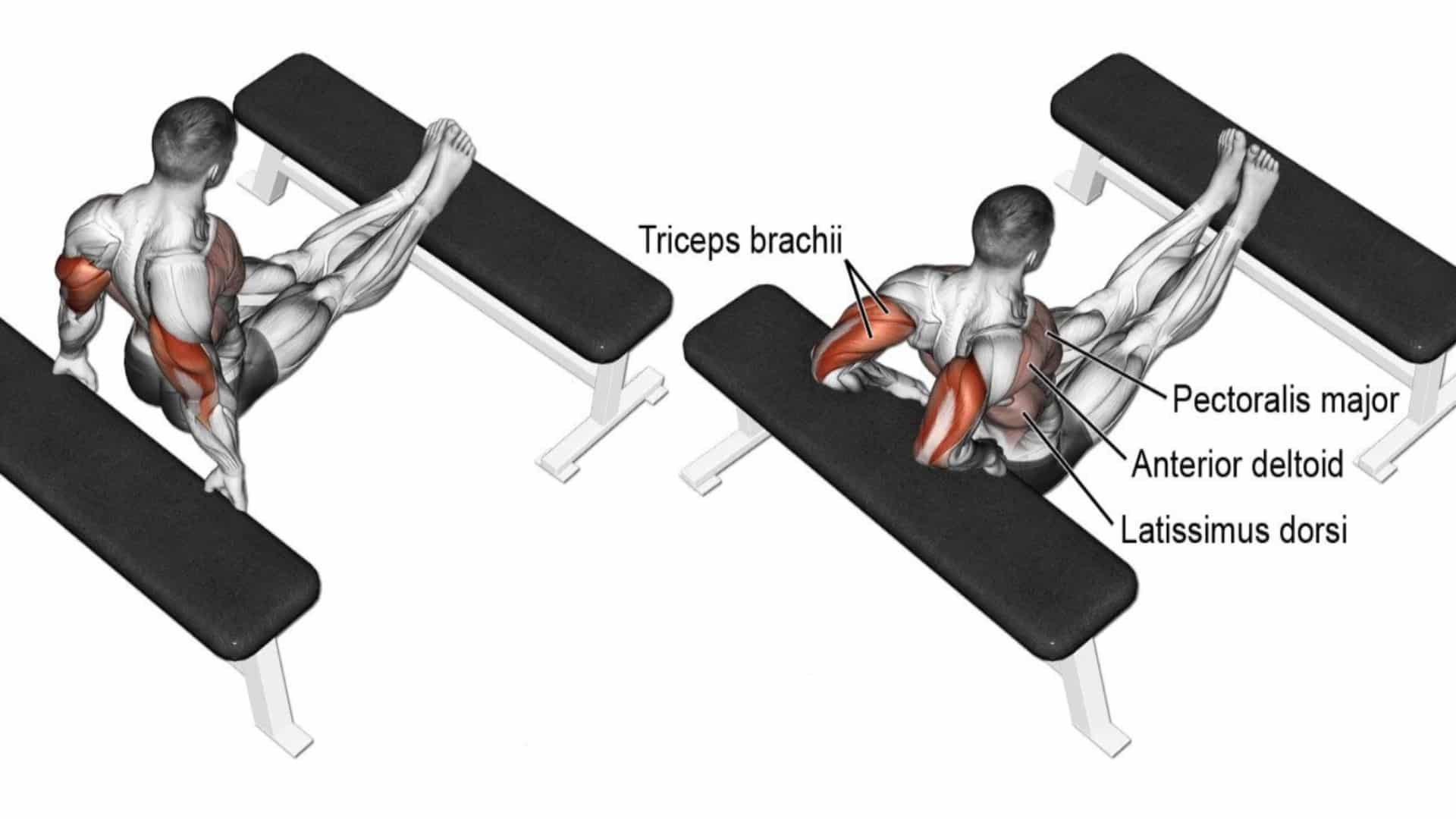
How To Do Tricep Bench Dip
The feet-elevated bench dip is a popular bodyweight exercise for building triceps, chest, and shoulders. Elevating the feet increases the chest and shoulder movement, allowing you to lift more weight.
- Position two flat benches parallel to each other, approximately 4–5 feet apart. You can adjust the distance according to your height.
- Place your hands on the side of a flat bench, shoulder-width apart, so your body is perpendicular to the bench.
- Place your feet on the edge of the other, so your legs are suspended between the two.
- Keep your body close to the bench as you begin the dip.
- Bend your elbows to lower your body down until your elbows reach 90 degrees.
- Now, extend your arms to lift your body back to the starting position, flexing your triceps hard at the top.
- Continue to dip and rise. Do 8–12 reps and 3–4 sets.
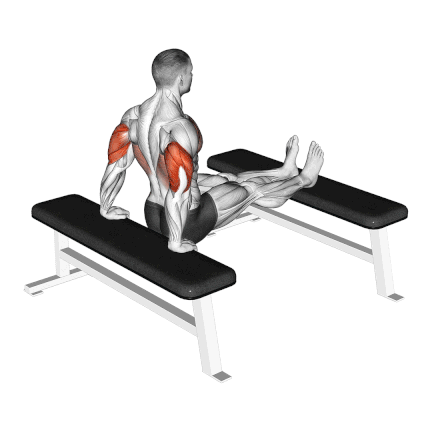
Avoid This Common Mistakes While Doing Bench Dips
The bench dip must be done perfectly to activate the necessary muscle groups. If you avoid the common mistakes, this exercise will give you the most out of it.
1. Not Doing Complete Reps
Completing partial reps instead of a full rep will not fully engage the triceps, negating some of the exercise’s benefits. Ensure you lower down until your upper arm is parallel to the ground and your elbow forms a 90-degree angle.
2. Flaring Elbows Out
When you let your elbows flare out, you move the tension from your triceps to your shoulders, which can cause injury. Ensure that your elbows stay tucked into your body throughout the dip.
3. Leaning Too Far Forward
Keep your chest high and open, look straight ahead, and don’t round your shoulders or hunch forward when you move.
You must start in an upright position. Leaning forward will focus on your chest and shoulder muscles, not your triceps.
4. Going too Low
If you go too low in the dip, you’ll put too much pressure on your shoulder. Stop when your upper arms are parallel to the floor and rise back up.
Stop at the 90-degree elbow angle mark that makes your arms parallel to the floor. This would help you use your movements to the fullest.
5. Locking Elbows
You shouldn’t lock your elbow at the top of the movement. Keeping them slightly soft maintains tension on the triceps.
6. Doing Reps too Quick
If you rely on momentum to complete each rep, you miss out on many benefits of the move. Move slowly and with control for maximum results.
7. Start Lifting Heavy
You should only do weight bench dips after you’ve mastered your bodyweight bench dips and can do them in a controlled manner. Never compromise form to lift more weight. It’s safer and more sensible to build up gradually.
The results may pleasantly surprise you if you make your form more strict and tighter.
8. Not Following Optimum Sets, Reps, & Frequency for Bench Dip
Customizing bench dip sets, reps, and frequency is important based on your fitness goals, current strength level, and overall workout routine.
The specific numbers may vary, but here are some general guidelines to help you.
| Level | Sets | Reps | Frequency |
|---|---|---|---|
| Beginner | 2-3 | 8-12 | 1 times per week |
| Intermediate | 3-4 | 10-15 | 1–2 times per week |
| Advanced | 4-5 | 12-15 | 2–3 times per week (with rest days) |
Bench Dip Variations (Make It Easier Or Harder)
Modifying the bench dip can increase or decrease the intensity of muscle response. Changing the leg positions and adding weights to your routine will significantly affect how the muscles respond.
- If you want to make bench dips easier, do them with Knees Bent.
- The next level up in difficulty is to extend the legs out straight with the heels on the floor. Straightening your legs and putting your feet farther away (heels on the floor) will be harder. This version is easy to do because you’re not lifting much of your body weight, and it doesn’t require a lot of flexibility.
- To make bench dips harder, you can increase the number of sets and the number of times you do them.
- Or doing a single-arm bench dip. When bench dips with your feet up get too easy, you can have a workout partner put a weight plate on your thigh to make it harder.
1. Knee Bent Bench Dip
The bent knee bench dip is easier than the standard bodyweight dip because it requires less physical strength. It is a medium-intensity exercise that uses your own body weight to strengthen your triceps.
It hits all three heads of the triceps (Long, medial, short), which is very important for developing maximum size and strength gains.
Bench dips are easy to learn and can be done almost anywhere, making them a great home exercise for beginners.
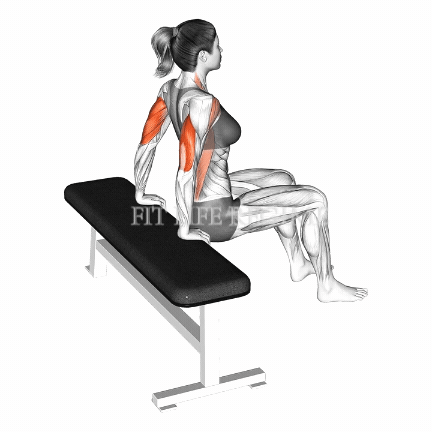
How To Do Knee Bent Bench Dip
- Place your hands on the side of a flat bench so that your body is perpendicular to the bench when you place your feet out in front of you.
- Only your heels should be on the floor, and your legs should be straight. Keep your knees and hips bent.
- Your arms should be fully extended with just your palms on the bench.
- Bend your elbows to lower your body down until your elbows reach 90 degrees.
- Now, extend your arms to raise your body back to the starting position.
Read More: Long Head Triceps Exercises For Bigger, Stronger Arms
2. Bench Dip With Straight Legs
A tricep bench dip with straight legs is a simpler version of the standard bench dip. You can use it to build your arms at home, at the gym, or even on a park bench while you’re running in the morning.
While still a beginner-friendly move, this variation is slightly tougher because you have to lift and lower a higher proportion of your own bodyweight.
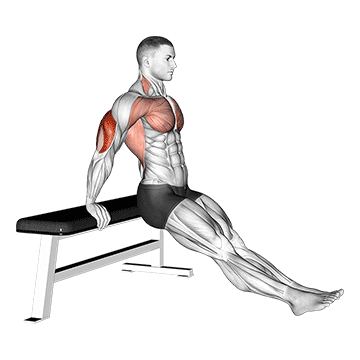
How To Do Bench Dip With Straight Legs
- Position your hands shoulder-width apart on a secured bench or stable chair.
- Slide your butt off the front of the bench with your legs extended out in front of you.
- Your arms should be fully extended with just your palms on the bench.
- Bend your elbows to lower your body down until your elbows reach 90 degrees.
- Now, extend your arms to lift your body back to the starting position, flexing your triceps hard at the top.
3. Weighted Bench Dip
Adding weight to your bench dips makes this exercise more difficult and requires your triceps and chest to work harder. This increased intensity results in faster muscle growth and strength gains than using your bodyweight.
With weighted bench dips, you have complete control over the resistance. You can easily add or remove weight to match your current strength level perfectly.
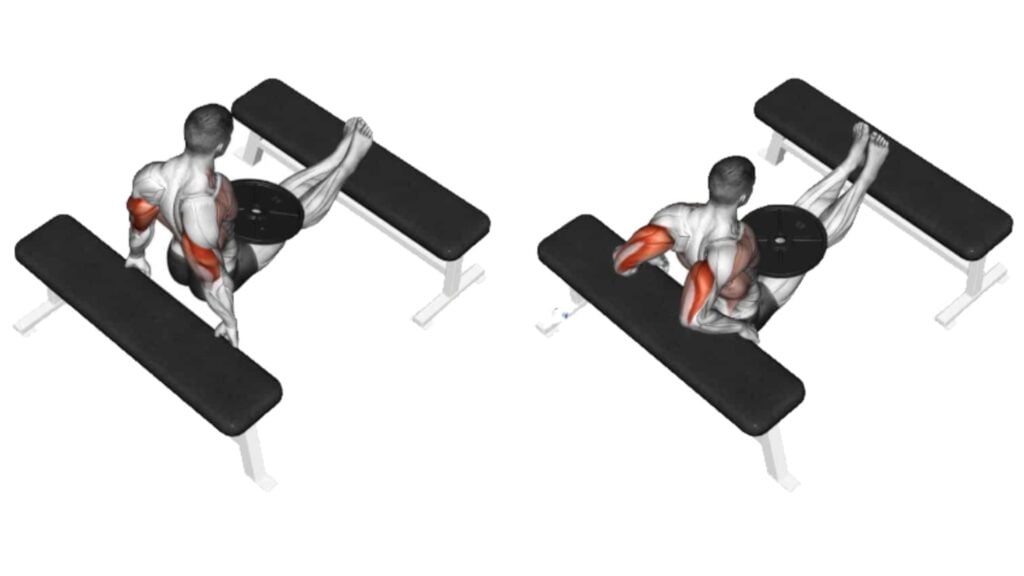
How To Do Weighted Bench Dip
- Place your hands on the edge of a bench and extend your legs in front of you, resting your feet on another bench.
- Have a training partner place a weight plate on your thighs.
- Keeping your body close to the bench, bend your elbows and lower your butt, stopping when your upper arms are parallel to the floor.
- Slowly push back up while squeezing your triceps. Do not lock the elbows out at the top of the exercise.
- Do 8–12 reps, and then have your partner take a plate off so you can keep going.
4. One-arm Bench Dip
The one-arm bench dip is a challenging and very effective movement that primarily targets your triceps, but your glutes and quads also get worked secondarily.
However, this is not a beginner’s exercise or for someone with inadequate upper body strength. For an easier variation, you can do a bench dip.
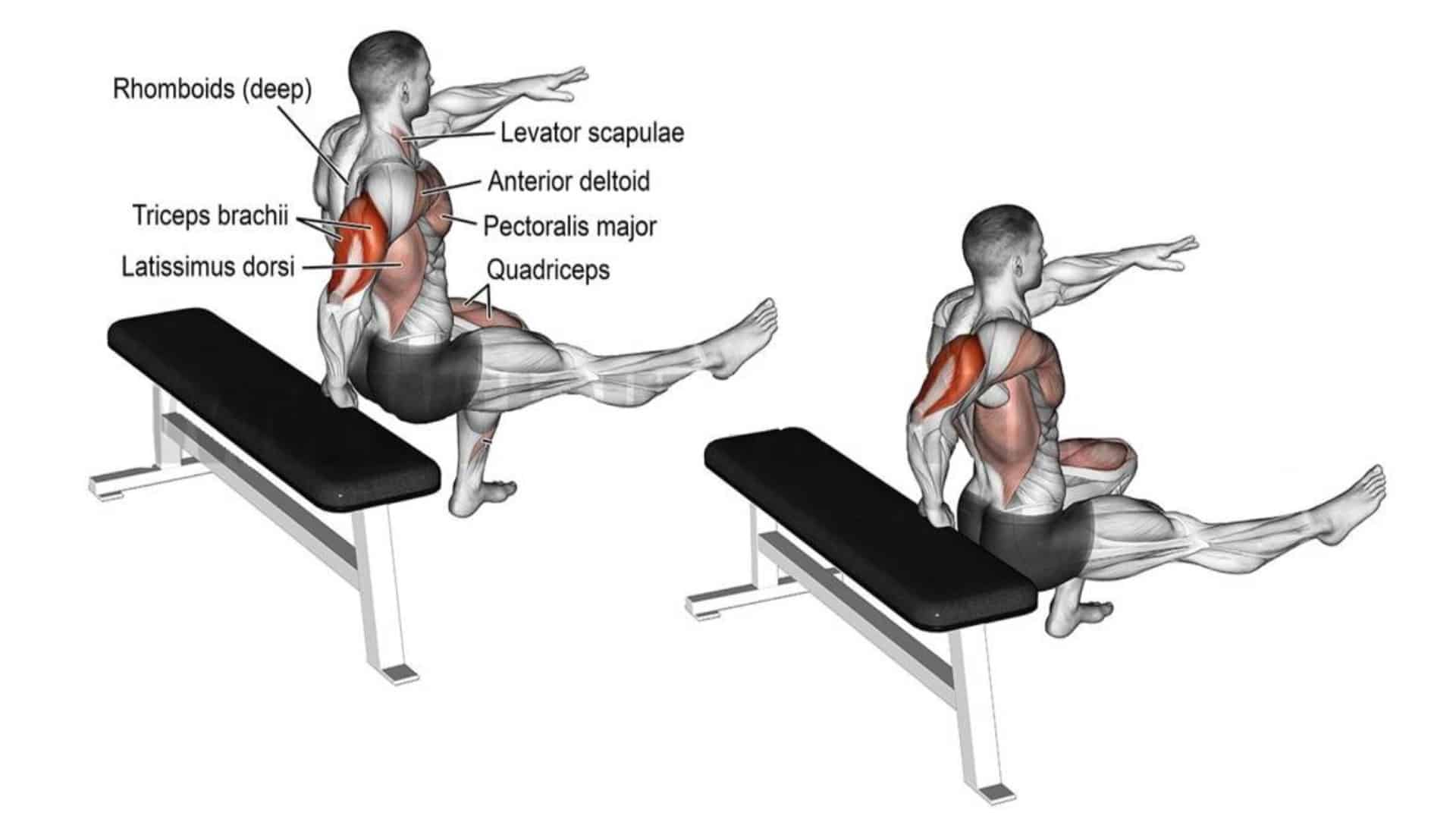
How To Do One Arm Bench Dip
- Place your hands (palms) on the side of a flat bench with your back straight, knees bent, and feet flat on the floor.
- Slide your buttocks off the bench. Raise your left arm and right leg straight out in front of you.
- Your bodyweight should be supported by your right arm and left leg.
- Inhale as you flex your elbow to lower your body until you feel a mild stretch in your shoulder.
- Exhale as you extend your elbow to push your body back up to the starting position. Squeeze the tricep to feel it.
- Repeat for the desired number of repetitions and repeat the exercise with your left arm.
FAQ
Do dips work all 3 heads?
Yes, dips work all three heads of the triceps: the lateral, medial, and long heads.
Can I do bench dips every day?
No, it is not recommended to do bench dips every day. It’s best to rest for a day or two between bench dip sessions to help your tricep and other muscles recover.
Are dips better than push-ups?
Dips and push-ups are both effective exercises that target different muscle groups. While dips primarily focus on the triceps and chest, push-ups engage the chest, triceps, shoulders, and core. Both exercises have benefits and can be part of a good workout routine.
How can you add this In routine?
Add bench dips to an upper-body workout to target your chest and triceps. Continue to inch your feet out week after week, progressing to more advanced variations to challenge yourself.
Do bench dips work the lower chest?
The Bench Dip is a great exercise for building the triceps, the lower chest, and the front of the shoulders.
How Many sets and Reps?
Begin with 3 sets of 10 repetitions and increase your sets and reps over several weeks as you build muscle and strength in your triceps.
Takeaways
Bench dip is the best bodyweight exercise because it works your triceps the most and your chest and anterior deltoid.
Dips are a great addition to the workout plan regardless of your fitness goals.
Stay Fit, Live A Happy and Healthy Life
References
- McKenzie A, Crowley-McHattan Z, Meir R, Whitting J, Volschenk W. Bench, Bar, and Ring Dips: Do Kinematics and Muscle Activity Differ? Int J Environ Res Public Health. 2022 Oct 14;19(20):13211. doi: 10.3390/ijerph192013211. PMID: 36293792; PMCID: PMC9603242.
- Bagchi, a. (2015). A comparative electromyographical investigation of triceps brachii and pectoralis major during four different freehand exercises.

Manish is a NASM-certified fitness and nutrition coach with over 10 years of experience in weight lifting and fat loss fitness coaching. He specializes in gym-based training and has a lot of knowledge about exercise, lifting technique, biomechanics, and more.
Through “Fit Life Regime,” he generously shares the insights he’s gained over a decade in the field. His goal is to equip others with the knowledge to start their own fitness journey.

